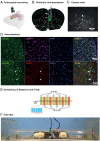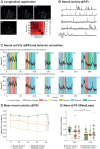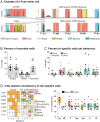Ca2+ imaging of self and other in medial prefrontal cortex during social dominance interactions in a tube test
- PMID: 35881809
- PMCID: PMC9353509
- DOI: 10.1073/pnas.2107942119
Ca2+ imaging of self and other in medial prefrontal cortex during social dominance interactions in a tube test
Abstract
The study of social dominance interactions between animals offers a window onto the decision-making involved in establishing dominance hierarchies and an opportunity to examine changes in social behavior observed in certain neurogenetic disorders. Competitive social interactions, such as in the widely used tube test, reflect this decision-making. Previous studies have focused on the different patterns of behavior seen in the dominant and submissive animal, neural correlates of effortful behavior believed to mediate the outcome of such encounters, and interbrain correlations of neural activity. Using a rigorous mutual information criterion, we now report that neural responses recorded with endoscopic calcium imaging in the prelimbic zone of the medial prefrontal cortex show unique correlations to specific dominance-related behaviors. Interanimal analyses revealed cell/behavior correlations that are primarily with an animal's own behavior or with the other animal's behavior, or the coincident behavior of both animals (such as pushing by one and resisting by the other). The comparison of unique and coincident cells helps to disentangle cell firing that reflects an animal's own or the other's specific behavior from situations reflecting conjoint action. These correlates point to a more cognitive rather than a solely behavioral dimension of social interactions that needs to be considered in the design of neurobiological studies of social behavior. These could prove useful in studies of disorders affecting social recognition and social engagement, and the treatment of disorders of social interaction.
Keywords: endoscopic imaging; prefrontal cortex; rodents; social dominance; tube test.
Conflict of interest statement
The authors declare no competing interest.
Figures





Similar articles
-
Correlated Neural Activity and Encoding of Behavior across Brains of Socially Interacting Animals.Cell. 2019 Jul 11;178(2):429-446.e16. doi: 10.1016/j.cell.2019.05.022. Epub 2019 Jun 20. Cell. 2019. PMID: 31230711 Free PMC article.
-
Regulation of social interaction in mice by a frontostriatal circuit modulated by established hierarchical relationships.Nat Commun. 2023 Apr 29;14(1):2487. doi: 10.1038/s41467-023-37460-6. Nat Commun. 2023. PMID: 37120443 Free PMC article.
-
Social dominance differentially alters gene expression in the medial prefrontal cortex without affecting adult hippocampal neurogenesis or stress and anxiety-like behavior.FASEB J. 2019 Jun;33(6):6995-7008. doi: 10.1096/fj.201801600R. Epub 2019 Mar 11. FASEB J. 2019. PMID: 30857420
-
The mouse that roared: neural mechanisms of social hierarchy.Trends Neurosci. 2014 Nov;37(11):674-82. doi: 10.1016/j.tins.2014.07.005. Epub 2014 Aug 24. Trends Neurosci. 2014. PMID: 25160682 Review.
-
Social status and modern-type depression: A review.Brain Behav. 2019 Dec;9(12):e01464. doi: 10.1002/brb3.1464. Epub 2019 Nov 19. Brain Behav. 2019. PMID: 31743626 Free PMC article. Review.
Cited by
-
Behavioral tests for the assessment of social hierarchy in mice.Front Behav Neurosci. 2025 Mar 5;19:1549666. doi: 10.3389/fnbeh.2025.1549666. eCollection 2025. Front Behav Neurosci. 2025. PMID: 40110389 Free PMC article. Review.
-
Endocannabinoid signaling regulates post-operative delirium through glutamatergic mediodorsal thalamus-prelimbic prefrontal cortical projection.Front Aging Neurosci. 2022 Dec 1;14:1036428. doi: 10.3389/fnagi.2022.1036428. eCollection 2022. Front Aging Neurosci. 2022. PMID: 36533179 Free PMC article.
-
Mesocorticolimbic circuit mechanisms of social dominance behavior.Exp Mol Med. 2024 Sep;56(9):1889-1899. doi: 10.1038/s12276-024-01299-8. Epub 2024 Sep 2. Exp Mol Med. 2024. PMID: 39218974 Free PMC article. Review.
-
Prior experience with behavioral control over stress facilitates social dominance.Neurobiol Stress. 2023 Dec 6;28:100597. doi: 10.1016/j.ynstr.2023.100597. eCollection 2024 Jan. Neurobiol Stress. 2023. PMID: 38213318 Free PMC article.
-
Social dominance in rats is a determinant of susceptibility to stress.Proc Natl Acad Sci U S A. 2025 May 13;122(19):e2412314122. doi: 10.1073/pnas.2412314122. Epub 2025 May 9. Proc Natl Acad Sci U S A. 2025. PMID: 40344000
References
-
- Ricceri L., Moles A., Crawley J., Behavioral phenotyping of mouse models of neurodevelopmental disorders: Relevant social behavior patterns across the life span. Behav. Brain Res. 176, 40–52 (2007). - PubMed
-
- Crawley J. N., What’s Wrong with My Mouse? Behavioral Phenotyping of Transgenic and Knockout Mice (Wiley, Hoboken, NJ, ed. 2, 2006).
-
- Lindzey G., Winston H., Manosevitz M., Social dominance in inbred mouse strains. Nature 191, 474–476 (1961). - PubMed
-
- Fan Z., et al. , Using the tube test to measure social hierarchy in mice. Nat. Protoc. 14, 819–831 (2019). - PubMed
-
- Wang F., et al. , Bidirectional control of social hierarchy by synaptic efficacy in medial prefrontal cortex. Science 334, 693–697 (2011). - PubMed
Publication types
MeSH terms
Substances
Grants and funding
LinkOut - more resources
Full Text Sources
Miscellaneous

